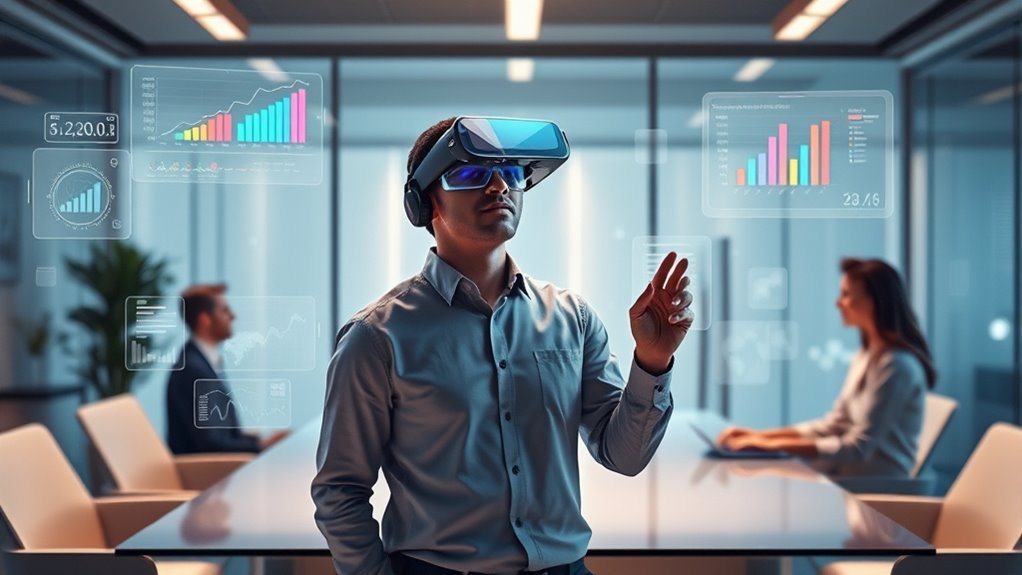Mixed reality workspaces are transforming collaboration by blending digital and physical environments seamlessly. You can manipulate virtual objects, interact with shared models, and communicate more naturally, even from afar. These environments remove barriers of remote work, making meetings more immersive and productive. With ongoing technological advances, your workspace will become more intuitive and connected, fostering better teamwork. Stay with us to explore how these innovations are shaping the future of how you work together.
Key Takeaways
- Integrates digital and physical environments to create immersive, interactive workspaces that enhance collaboration and presence.
- Enables real-time manipulation and annotation of shared virtual objects, reducing misunderstandings and speeding up decision-making.
- Overcomes remote work barriers by mimicking physical meetings, facilitating detailed reviews, and improving engagement.
- Offers customizable interfaces with multi-screen displays and tool access, streamlining workflows and boosting productivity.
- Continually advances through improved responsiveness and natural interactions, shaping a more seamless, connected future of teamwork.

Mixed reality workspaces are transforming the way you collaborate and complete tasks by blending digital and physical environments seamlessly. These environments make remote teamwork feel more natural and interactive, bridging the gap between geographically dispersed team members. Instead of relying solely on video calls or static screens, you get to engage with virtual interfaces that mimic real-world interactions. This creates a sense of presence and immediacy, making collaboration feel almost tangible.
Mixed reality workspaces bridge digital and physical worlds, making remote collaboration more natural, interactive, and immersive.
With mixed reality, you can see and manipulate digital objects as if they were part of your physical space. When working on projects with colleagues from different locations, you don’t need to imagine what’s happening on their end; you can directly interact with shared virtual models or documents. This hands-on approach reduces misunderstandings, accelerates decision-making, and fosters a more intuitive workflow. Virtual interfaces serve as your collaborative canvas, allowing you to annotate, highlight, and adjust designs in real time alongside your team members, regardless of where they are.
Remote teamwork becomes more effective because mixed reality eliminates many barriers of traditional remote work. Instead of static video conferences, you’re immersed in a shared virtual environment that enhances communication and coordination. You can walk around a digital prototype, point out specific features, and get immediate feedback, just like in a physical meeting. The immersive nature of mixed reality helps you stay engaged, minimizes distractions, and boosts productivity. It’s like bringing your team into the same room without the logistical challenges of travel or space constraints.
Virtual interfaces within mixed reality workspaces are customizable, enabling you to tailor your workspace to suit your needs. You can pin important data, access tools, or display multiple screens simultaneously, all within your physical environment. This integration gives you a more streamlined experience, making multitasking more manageable. As you become more adept at traversing these virtual interfaces, you’ll find that complex tasks are completed faster and with greater precision. The technology encourages a more dynamic, interactive approach to collaboration, where ideas flow freely and adjustments happen in real-time.
Furthermore, advancements in high refresh rates and low input lag enhance the responsiveness of virtual interfaces, making interactions smoother and more natural. In essence, mixed reality workspaces are not just a futuristic concept—they’re actively reshaping how teams work together across distances. By leveraging virtual interfaces and enhancing remote teamwork, they create an environment where collaboration is more natural, efficient, and engaging. As these technologies continue to evolve, expect your work experience to become more seamless, intuitive, and connected than ever before.
Frequently Asked Questions
How Secure Are Data Transmissions in Mixed Reality Workspaces?
Data transmissions in mixed reality workspaces are quite secure, thanks to robust encryption protocols that protect your information during transfer. However, you should also consider data sovereignty, ensuring your data stays within legal and regional boundaries. By choosing platforms with strong encryption and clear data policies, you can confidently collaborate in XR environments, knowing your sensitive information remains private and protected from unauthorized access.
Can Mixed Reality Workspaces Support Real-Time Language Translation?
Yes, mixed reality workspaces can support real-time language translation, helping you overcome language barriers and facilitate seamless communication. You’ll see instant translations during live interactions, making collaboration smoother and more inclusive. This technology enhances real-time communication by breaking down language differences, allowing global teams to work together effortlessly. As a result, you can focus more on your tasks without worrying about misunderstandings or misinterpretations, boosting productivity and teamwork.
What Are the Ergonomic Considerations for Prolonged XR Workspace Use?
You should prioritize ergonomic design to prevent discomfort during prolonged XR workspace use. Ensure your headset fits well, supports good posture, and reduces strain on your neck and eyes. Take regular breaks, adjust the device for ideal user comfort, and incorporate ergonomic accessories like supportive chairs or stands. Paying attention to ergonomic considerations helps maintain comfort, reduces fatigue, and enhances your overall productivity in extended XR sessions.
How Do Mixed Reality Workspaces Integrate With Existing Enterprise Systems?
Imagine your enterprise systems as a bustling city’s interconnected streets; mixed reality workspaces act as the bridges linking them seamlessly. You’ll integrate MR with existing enterprise systems through APIs and middleware, ensuring smooth data flow. Prioritizing system interoperability, you connect platforms like ERP, CRM, and communication tools, creating a unified digital ecosystem. This integration enhances collaboration, boosts efficiency, and transforms your workspace into a vibrant, interconnected cityscape.
Are There Specific Hardware Requirements for Optimal Mixed Reality Collaboration?
You’ll want hardware that’s compatible with your mixed reality platform, ensuring seamless integration with your existing systems. Pay attention to display resolution, as higher resolution provides clearer visuals and a more immersive experience. Check that your devices support necessary sensors and processing power for smooth collaboration. Ultimately, choosing hardware with ideal compatibility and display resolution will enhance your mixed reality workspace, making collaboration more effective and engaging.
Conclusion
As you embrace mixed reality workspaces, you’re stepping into a future where collaboration feels seamless. With 78% of companies exploring XR solutions, it’s clear this technology is transforming how teams connect and innovate. Imagine working alongside digital holograms or sharing immersive data insights in real-time. By adopting XR, you’re not just keeping up—you’re leading the way into a more dynamic, interactive, and efficient workspace that redefines teamwork in the digital age.








